|
 |
 |
 |
| Dalada Maligawa |
Kandy ’s main attraction is the Dalada Maligawa, the Temple of the Sacred Tooth Relic of the Buddha, the founder of Buddhism. Brought to Sri Lanka in the 4th c. A.D., the sacred relic has ever since been the symbol of sovereignty for its rulers, it has been enshrined in great splendour from time immemorial.
Kandy’s Dalada Maligawa is a magnificent shrine, with decorative walls, moat, turrets,a golden roof and fine wood-work and its 16th – 19th century ambience remains vivid. Three religious services (pooja) with traditional music, held daily at dawn, mid-day and in the evening, can be viewed by visitors.
Wikipedia...
|
|
| Kelaniya Temple |

This temple, consecrated during the third and final visit of Lord Buddha to Sri Lanka, eight years after gaining enlightenment, is situated 7 miles from Colombo in the Gampaha District on the banks of the Kelaniya River. It has a history of nearly 2563 years.The Mahawansa records that the original Dagoba at Kelaniya enshrined a gem-studded throne on which the Buddha sat and preached. The temple is also famous for its image of the reclining Buddha and paintings which depict important events in the life of the Buddha, in the history of Buddhism in Sri Lanka, also incidents from the Jataka tale (Folk Tales). lt is the venue of the annual Duruthu Perahera held in the month of January.
Wikipedia... |
|
| Adam’s Peak |
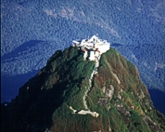 It is believed that Lord Buddha placed his footprint on the summit of this sacred mountain during his third visit to the isle, hence the name Sri Pada which literally means 'the sacred footprint'.
Adam's Peak is a pilgrimage for four religions.It is 7,360 feet in height and is the forth highest mountain in the country and has several approaches, the main ones being through the Hatton town and Ratnapura District. Annually, from December to April, devotees climb the mountain to pay homage to the holy site.
Wikipedia... |
|
| Dambulla Vihara |

Located north of Kandy and considered by most to be the center point of SriLanka, Dambulla is a town built around a vast isolated rock mass measuring 500 ft. It is a UNESCO World Heritage Site.It was here that King Valagambahu took refuge in the 1st century B.C. The view from the top of this rock is breathtaking 350 ft.above are a series of five caves which was later turned into a magnificent rock temple by King Valagambahu.
In the first cave is a recumbent image of the Buddha 47 ft, long , cut out from the rock. There are images of deities associated with Buddhism. The frescoes on the walls and ceiling could be dated to the 15th - 18th centuries. In the second cave, the finest and the largest , are not less than 150 life size statues of gods. There are numerous images of the Buddha as well. The ceiling too is covered with frescoes which depict great events in the life of the Buddha , and landmarks in the history of the Sinhala People.
Wikipedia... |
|
| Sigiriya Rock |
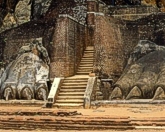 The history of Sigiriya dates back to over 5000 thousand years. One of Sri Lanka’s major attractions and a World Heritage Site, Sigiriya(Lion Rock) came into prominence in the 5th centaury AD, when the patricidal King Kasyapa, afraid of reprisals led by his half - brother, Mogolan, chose to move the seat of power from Anuradhapura to this 500m rock.
It was Kasyapa and his master-builders who were responsible for the complex plan which made Sigiriya the glorious capital it was, for 17 years (477 – 495 AD). The frescoes of the ‘ heavenly maidens ‘ halfway up the rock in a sheltered gallery, are the only painted renderings of a secular subject in this country.The 'mirror wall ‘, which records the poetic outpourings of early visitors to the rock and the colossal plan of the royal palace, water gardens and fortifications, is entirely fascinating.
Wikipedia... |
|
| Mahinyangana Maha Seya |
This Chetiya (stupa) was built during the lifetime of Lord Buddha enshrining the lock of hair given by Him to God Saman on the occasion of His first visit to Sri Lanka, nine months after attaining enlightenment. It is the first ever stupa to be constructed in Sri Lanka.
It was enlarged by Arhat Sarabhu to a Chetiya 12 cubic feet high after receiving and enshrining the collar bone relic of the Buddha taken from the funeral pyre. Subsequently it was enlarged and rebuilt byvarious Kings and restored again during modern times. Wikipedia... |
|
| Ruwanveliseya |
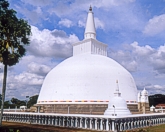
Situated in Anuradhapura. It was built in the second century B.C by King Dutugamunu. It is 100 metres tall, 77 metres wide, 300 ft in diameter.
Originally the stupa was designed in a " Bubble " shape . Sadly different restorations of the sthupa have altered its original shape. The Great Sthupa cost the King 6.4 million coins in wages. The construction was commenced on a full moon day in May 144 B.C. The foundation was made of butter-clay, imported from India, which was used as cement. Further four small Stupas are to be seen in the four corners in order to give more respect.
Walking around the stupa you see a life size statue of a king, believed to be King Dutugamunu.
Wikipedia... |
|
| Gal Viharaya |
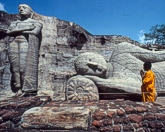 Located in the ancient city of Polonnaruwa and built in the 12th century A.D by the great King Parakramabahu the 1st. It is a group of Buddha images that mark the excellence of Sinhalese rock carving.The Gal Viharaya consists of four seperate images of different postures carved and cut from one long slab of granite.
First is a samadhi image in meditation posture, the second is inside a cave and the third is a standing Buddha image which is 23 ft in height and the forth is a recumbent Buddha image measuring 46 feet, depicting the passing away. Wikipedia... |
|
| Wewurukannala Vihara |

15 miles east of Matara is the town of Dickwella, where there is one of the most amazing Buddhist temples in Sri Lanka. The Wewurukannala Vihara temple is dominated by an image of a seated Buddha. It is 160ft high, the largest statue in all of Sri Lanka and dates back to the time of King Rajadhi (1782 - 1798).
The temple has three parts, the oldest being about 250 years old; however this is of no particular interest.
The next part has life size models of demons and sinners, varied and grotesque forms of punishments. Finally there is the enormous seated Buddha that is as high as an eight-storied building.
The temple walls show you events in the Buddha's life. |
|
| Buduruwagala Rock Sculptures |
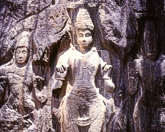 Located 5kms south of Wellawaya accessible through a road which branches west off the road to Tissa leading to the rock cut Buddha figures of Buduruwagala. Buduruwagala means stone images of Buddha.The figures date back to 10th century AD.The Buddha statue still bears traces of its original stuccoedrobe and a long streak of orange suggests it was once brightly painted.Photos... |
|
|
| Kataragama Devalaya |
|
One of Sri Lanka’s holy places where Hindus, Buddhists and Muslims visit on religious pilgrimage. It is a large Complex with the `Mahadewala’ – Main Hindu shrine being the most important place. Wikipedia... |
| Tirukoneswaram Kovil |
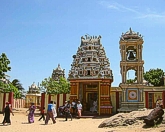 At the northeastern most tip of the Fort Frederick's promontory is a cliff known as Swami Rock, dropping about 360 feet directly into the sea. On its topmost pinnacle is the Tirukonesvaram Kovil , destroyed by the Portuguese though the Kovil was restored and completed in 1963.
Three ancient bronze images and a Shiva lingam, later found by divers at the bottom of the cliff beneath the temple , were installed for worship. Puja services are especially colorful at twilight on Fridays. Trincomalee may take its name from the site of this temple - perhaps from the Tamil words tiru kona malai , " mountain scared to Konesvara ( Shiva )." |
|
|
|
|
 |
| Source: Srilankan Tourism |
|